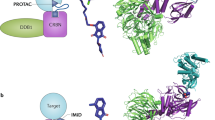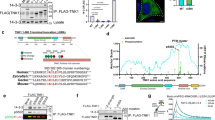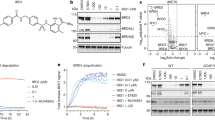Abstract
Interrogating specific cellular activities often entails the dissection of posttranslational modifications or functional redundancy conferred by protein families, which demands more sophisticated research tools than simply eliminating a specific gene product by gene targeting or RNA interference. We have developed a novel methodology that involves engineering a single SCFβTrCP-based ubiquitin ligase that is capable of not only simultaneously targeting the entire family of ErbB receptor tyrosine kinases for ubiquitination and degradation, but also selectively recruiting only activated ErbBs. The engineered SCFβTrCP ubiquitin ligase effectively blocked ErbB signaling and attenuated oncogenicity in breast cancer cells, yet had little effect on the survival and growth of non-cancerous breast epithelial cells. Therefore, engineering ubiquitin ligases offers a simple research tool to dissect the specific traits of tumorigenic protein families, and provides a rapid and feasible means to expand the dimensionality of drug discovery by assessing protein families or posttranslational modifications as potential drug targets.
This is a preview of subscription content, access via your institution
Access options
Subscribe to this journal
Receive 50 print issues and online access
$259.00 per year
only $5.18 per issue
Buy this article
- Purchase on Springer Link
- Instant access to full article PDF
Prices may be subject to local taxes which are calculated during checkout







Similar content being viewed by others
References
Guy CT, Webster MA, Schaller M, Parsons TJ, Cardiff RD, Muller WJ . Expression of the neu protooncogene in the mammary epithelium of transgenic mice induces metastatic disease. Proc Natl Acad Sci USA 1992; 89: 10578–10582.
Hynes NE, Stern DF . The biology of erbB-2/neu/HER-2 and its role in cancer. Biochim Biophys Acta 1994; 1198: 165–184.
Muller WJ, Sinn E, Pattengale PK, Wallace R, Leder P . Single-step induction of mammary adenocarcinoma in transgenic mice bearing the activated c-neu oncogene. Cell 1988; 54: 105–115.
Olayioye MA, Neve RM, Lane HA, Hynes NE . The ErbB signaling network: receptor heterodimerization in development and cancer. EMBO J 2000; 19: 3159–3167.
Yarden Y, Sliwkowski MX . Untangling the ErbB signalling network. Nat Rev Mol Cell Biol 2001; 2: 127–137.
Hynes NE, MacDonald G . ErbB receptors and signaling pathways in cancer. Curr Opin Cell Biol 2009; 21: 177–184.
Krause DS, Van Etten RA . Tyrosine kinases as targets for cancer therapy. N Engl J Med 2005; 353: 172–187.
Zhou P, Fernandes N, Dodge IL, Reddi AL, Rao N, Safran H et al. ErbB2 degradation mediated by the co-chaperone protein CHIP. J Biol Chem 2003; 278: 13829–13837.
Hynes NE, Lane HA . ERBB receptors and cancer: the complexity of targeted inhibitors. Nat Rev Cancer 2005; 5: 341–354.
Rabindran SK . Antitumor activity of HER-2 inhibitors. Cancer Lett 2005; 227: 9–23.
Klapper LN, Waterman H, Sela M, Yarden Y . Tumor-inhibitory antibodies to HER-2/ErbB-2 may act by recruiting c-Cbl and enhancing ubiquitination of HER-2. Cancer Res 2000; 60: 3384–3388.
Sarikas A, Hartmann T, Pan ZQ . The cullin protein family. Genome Biol 2011; 12: 220.
Zhou P . Targeted protein degradation. Curr Opin Chem Biol 2005; 9: 51–55.
Zhou P, Bogacki R, McReynolds L, Howley PM . Harnessing the ubiquitination machinery to target the degradation of specific cellular proteins [In Process Citation]. Mol Cell 2000; 6: 751–756.
Zhang J, Zheng N, Zhou P . Exploring the functional complexity of cellular proteins by protein knockout. Proc Natl Acad Sci USA 2003; 100: 14127–14132.
Cong F, Zhang J, Pao W, Zhou P, Varmus H . A protein knockdown strategy to study the function of beta-catenin in tumorigenesis. BMC Mol Biol 2003; 4: 10.
Su Y, Ishikawa S, Kojima M, Liu B . Eradication of pathogenic beta-catenin by Skp1/Cullin/F box ubiquitination machinery. Proc Natl Acad Sci USA 2003; 100: 12729–12734.
Cohen JC, Scott D, Miller J, Zhang J, Zhou P, Larson JE . Transient in utero knockout (TIUKO) of C-MYC affects late lung and intestinal development in the mouse. BMC Dev Biol 2004; 4: 4.
Liu J, Stevens J, Matsunami N, White RL . Targeted degradation of beta-catenin by chimeric F-box fusion proteins. Biochem Biophys Res Commun 2004; 313: 1023–1029.
Chen W, Lee J, Cho SY, Fine HA . Proteasome-mediated destruction of the cyclin a/cyclin-dependent kinase 2 complex suppresses tumor cell growth in vitro and in vivo. Cancer Res 2004; 64: 3949–3957.
Hannah J, Zhou P . Maximizing target protein ablation by integration of RNAi and protein knockout. Cell Res 2011; 21: 1152–1154.
Suenaga A, Hatakeyama M, Kiyatkin AB, Radhakrishnan R, Taiji M, Kholodenko BN . Molecular dynamics simulations reveal that Tyr-317 phosphorylation reduces Shc binding affinity for phosphotyrosyl residues of epidermal growth factor receptor. Biophys J 2009; 96: 2278–2288.
Jones RB, Gordus A, Krall JA, MacBeath G . A quantitative protein interaction network for the ErbB receptors using protein microarrays. Nature 2006; 439: 168–174.
Sithanandam G, Anderson LM . The ERBB3 receptor in cancer and cancer gene therapy. Cancer Gene Ther 2008; 15: 413–448.
Schulze WX, Deng L, Mann M . Phosphotyrosine interactome of the ErbB-receptor kinase family. Mol Syst Biol 2005; 1: 2005 0008.
Yajnik V, Blaikie P, Bork P, Margolis B . Identification of residues within the SHC phosphotyrosine binding/phosphotyrosine interaction domain crucial for phosphopeptide interaction. J Biol Chem 1996; 271: 1813–1816.
Carraway KL . E3 ubiquitin ligases in ErbB receptor quantity control. Semin Cell Dev Biol 2010; 21: 936–943.
Longva KE, Blystad FD, Stang E, Larsen AM, Johannessen LE, Madshus IH . Ubiquitination and proteasomal activity is required for transport of the EGF receptor to inner membranes of multivesicular bodies. J Cell Biol 2002; 156: 843–854.
Sergina NV, Rausch M, Wang D, Blair J, Hann B, Shokat KM et al. Escape from HER-family tyrosine kinase inhibitor therapy by the kinase-inactive HER3. Nature 2007; 445: 437–441.
Panigada M, Porcellini S, Barbier E, Hoeflinger S, Cazenave PA, Gu H et al. Constitutive endocytosis and degradation of the pre-T cell receptor. J Exp Med 2002; 195: 1585–1597.
Sorkin A, Goh LK . Endocytosis and intracellular trafficking of ErbBs. Exp Cell Res 2008; 314: 3093–3106.
Castaneda CA, Cortes-Funes H, Gomez HL, Ciruelos EM . The phosphatidyl inositol 3-kinase/AKT signaling pathway in breast cancer. Cancer Metastasis Rev 2010; 29: 751–759.
Yang G, Cai KQ, Thompson-Lanza JA, Bast RC, Liu J . Inhibition of breast and ovarian tumor growth through multiple signaling pathways by using retrovirus-mediated small interfering RNA against Her-2/neu gene expression. J Biol Chem 2004; 279: 4339–4345.
Faltus T, Yuan J, Zimmer B, Kramer A, Loibl S, Kaufmann M et al. Silencing of the HER2/neu gene by siRNA inhibits proliferation and induces apoptosis in HER2/neu-overexpressing breast cancer cells. Neoplasia 2004; 6: 786–795.
Palmieri D, Bouadis A, Ronchetti R, Merino MJ, Steeg PS . Rab11a differentially modulates epidermal growth factor-induced proliferation and motility in immortal breast cells. Breast Cancer Res Treat 2006; 100: 127–137.
Worster DT, Schmelzle T, Solimini NL, Lightcap ES, Millard B, Mills GB et al. Akt and ERK control the proliferative response of mammary epithelial cells to the growth factors IGF-1 and EGF through the cell cycle inhibitor p57Kip2. Sci Signal 2012; 5: ra19.
Ross JS, Fletcher JA . The HER-2/neu oncogene in breast cancer: prognostic factor, predictive factor, and target for therapy. Stem Cells 1998; 16: 413–428.
Colomer R, Montero S, Lluch A, Ojeda B, Barnadas A, Casado A et al. Circulating HER2 extracellular domain and resistance to chemotherapy in advanced breast cancer. Clin Cancer Res 2000; 6: 2356–2362.
Burstein HJ, Kuter I, Campos SM, Gelman RS, Tribou L, Parker LM et al. Clinical activity of trastuzumab and vinorelbine in women with HER2-overexpressing metastatic breast cancer. J Clin Oncol 2001; 19: 2722–2730.
Marty M, Cognetti F, Maraninchi D, Snyder R, Mauriac L, Tubiana-Hulin M et al. Randomized phase II trial of the efficacy and safety of trastuzumab combined with docetaxel in patients with human epidermal growth factor receptor 2-positive metastatic breast cancer administered as first-line treatment: the M77001 study group. J Clin Oncol 2005; 23: 4265–4274.
Gasparini G, Gion M, Mariani L, Papaldo P, Crivellari D, Filippelli G et al. Randomized Phase II Trial of weekly paclitaxel alone versus trastuzumab plus weekly paclitaxel as first-line therapy of patients with Her-2 positive advanced breast cancer. Breast Cancer Res Treat 2007; 101: 355–365.
Garrett JT, Olivares MG, Rinehart C, Granja-Ingram ND, Sanchez V, Chakrabarty A et al. Transcriptional and posttranslational up-regulation of HER3 (ErbB3) compensates for inhibition of the HER2 tyrosine kinase. Proc Natl Acad Sci USA 2011; 108: 5021–5026.
Persons DA, Mehaffey MG, Kaleko M, Nienhuis AW, Vanin EF . An improved method for generating retroviral producer clones for vectors lacking a selectable marker gene. Blood Cells Mol Dis 1998; 24: 167–182.
Chen X, Zhang J, Lee J, Lin PS, Ford JM, Zheng N et al. A kinase-independent function of c-Abl in promoting proteolytic destruction of damaged DNA binding proteins. Mol Cell 2006; 22: 489–499.
Chen X, Zhang Y, Douglas L, Zhou P . UV-damaged DNA-binding proteins are targets of CUL-4A-mediated ubiquitination and degradation. J Biol Chem 2001; 276: 48175–48182.
He TC, Zhou S, da Costa LT, Yu J, Kinzler KW, Vogelstein B . A simplified system for generating recombinant adenoviruses. Proc Natl Acad Sci USA 1998; 95: 2509–2514.
Acknowledgements
We thank Bruce Mayer (University of Connecticut) for Shc plasmids, Alexandra Grassian for helpful discussions, and Jeffrey Hannah and Jennifer Lee for critical reading of the manuscript. This work is supported by National Institutes of Health Grant CA92792, the Irma T. Hirschl Career Scientist Award and the Speakers Fund from the New York Academy of Medicine to P.Z., and the Natural Science Foundation of China (No. 30901754) and Innovation Funding for Graduates of Tianjin Medical University, third Phase of the 211 Project for Higher Education (No. 2010GSI01).
Author information
Authors and Affiliations
Corresponding authors
Ethics declarations
Competing interests
The authors declare no conflict of interest.
Additional information
Supplementary Information accompanies the paper on the Oncogene website
Supplementary information
Rights and permissions
About this article
Cite this article
Kong, F., Zhang, J., Li, Y. et al. Engineering a single ubiquitin ligase for the selective degradation of all activated ErbB receptor tyrosine kinases. Oncogene 33, 986–995 (2014). https://doi.org/10.1038/onc.2013.33
Received:
Revised:
Accepted:
Published:
Issue Date:
DOI: https://doi.org/10.1038/onc.2013.33



